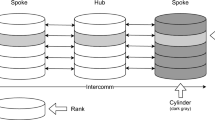Abstract
We parallelize the extended path method for solving rational expectations models, and apply it to compute perfect foresight competitive equilibrium for the global economy with multiple goods, regions, industries, and households. At each iteration, first intertemporal variables are updated, then equations for intra-temporal variables are solved in parallel. We compare serial, and parallel, versions of the extended path method in high-performance computing environments based on scenarios with long time horizons that include future populations, economic growth, energy use, and carbon dioxide emissions. Relative to the serial version, the speedup factor for the parallel extended path method grows almost linearly up to about 30 times with 18 cores, and computing times reduced from over 10 h for the serial version down to about 20 min for the parallel version.






Similar content being viewed by others
Notes
Use of block Jacobi preconditioning was demonstrated with blocks corresponding to one or several consecutive time periods.
Household preferences change over time and are mainly driven by demographic and income changes (Dalton et al. 2008; Melnikov et al. 2012; O’Neill et al. 2012). Allowing multiple household types within each region relaxes the representative household assumption, which adds substantial computing costs to the solution in terms of many more variables, including an additional state variable for each household type. For O’Neill et al. (2010a), it was not numerically feasible to allow multiple household types within each of the 9 regions. However, household heterogeneity can be an important factor in macroeconomic models (Heathcote et al. 2009), and there is growing interest in the effects of heterogeneity (Kaplan and Violante 2018). The solution method in this paper can accommodate multiple household types within each region.
Technical change is described using separate productivity coefficients in the CES production functions that change exogenously over time for each input of each production function in the model (Dalton et al. 2008).
For \(A_X^{OPR}\) this also includes OPR used in the land nest, \(A_X^{S} A_S^{OPR}\).
In practice one can choose the relaxation factors small enough to insure convergence, but a large number of iterations can be required to achieve prescribed tolerance level.
We use Intel Fortran compilers (for performance evaluation, see Tian et al. 2002).
By the speedup we mean the ratio of the parallel execution time on several processors to the execution time on a single processor. Generally there is some overhead in the parallel algorithm not present in the serial one due to various aspects of parallelization.
References
Adjemian, S., & Juillard, M. (2013). Stochastic extended path approach. Manuscript. CEIS Tor Vergata, Rome. Retrieved September 1, 2020 from http://www.ceistorvergata.it/public/CEIS/file/seminari/2013/Juillard.pdf.
Aguiar, A., Chepeliev, M., Corong, E., McDougall, R., & van der Mensbrugghe, D. (2019). The GTAP data base: Version 10. Journal of Global Economic Analysis, 4, 1–27.
Arrow, K., & Debreu, G. (1954). Existence of an equilibrium for a competitive economy. Econometrica, 22, 265–290.
Babiker, M., Gurgel, A., Paltsev, S., & Reilly, J. (2009). Forward-looking versus recursive-dynamic modeling in climate policy analysis: A comparison. Economic Modelling, 26, 1341–1354.
Calvin, K. V., Beach, R., Gurgel, A., Labriet, M., & Loboguerrero Rodriguez, M. (2016). Agriculture, forestry, and other land-use emissions in Latin America. Energy Economics, 56, 615–624.
Chapman, B., Jost, G., & van der Pas, R. (2008). Using OpenMP: Portable shared memory parallel programming. Cambridge, MA: MIT Press.
Christiano, L., Eichenbaum, M., & Trabandt, M. (2015). Understanding the great recession. American Economic Journal: Macroeconomics, 7, 110–167.
Dalton, M., & Goulder, L. (2001). An intertemporal general equilibrium model for analyzing global interactions between population, the environment and technology: PET model structure and data. Unpublished document. California State University, Monterey Bay. Retrieved September 1, 2020 from http://science.csumb.edu/~mdalton/EPA/pet.pdf.
Dalton, M., O’Neill, B., Prskawetz, A., Jiang, L., & Pitkin, J. (2008). Population aging and future carbon emissions in the United States. Energy Economics, 30, 642–675.
Dixon, P. B., Pearson, K., Picton, M. R., & Rimmer, M. T. (2005). Rational expectations for large CGE models: A practical algorithm and a policy application. Economic Modelling, 22, 1001–1019.
Fair, R., & Taylor, J. (1983). Solution and maximum likelihood estimation of dynamic nonlinear rational expectations models. Econometrica, 51, 1169–1185.
Gilli, M., & Pauletto, G. (1998). Krylov methods for solving models with forward-looking variables. Journal of Economic Dynamics and Control, 22, 1275–1289.
Goulder, L. (1995). Effects of carbon taxes in an economy with prior tax distortions: An intertemporal general equilibrium analysis. Journal of Environmental Economics and Management, 29, 271–297.
Gropp, W., Lusk, E., & Skjellum, A. (2014). Using MPI: Portable parallel programming with the message-passing interface (3rd ed.). Cambridge, MA: MIT Press.
Gruzdev, A., Melnikov, N., Dalton, M., Weitzel, M., & O’Neill, B. C. (2018). Parallel parameter optimization algorithm in dynamic general equilibrium models. IFAC-PapersOnLine, 51, 562–567.
Ha, P. V., & Kompas, T. (2016). Solving intertemporal CGE models in parallel using a singly bordered block diagonal ordering technique. Economic Modelling, 52, 3–12.
Heathcote, J., Storesletten, K., & Violante, G. (2009). Quantitative macroeconomics with heterogeneous households. Annual Review of Economics, 1, 319–354.
Horridge, M., Meeraus, A., Pearson, K., & Rutherford, T. F. (2013). Solution software for computable general equilibrium modeling. In P. B. Dixon & D. W. Jorgenson (Eds.), Handbook of computable general equilibrium modeling, chap 20 (pp. 1331–1381). Amsterdam: Elsevier.
Johansson, D. J. A., Lucas, P. L., Weitzel, M., Ahlgren, E. O., Bazaz, A. B., Chen, W., et al. (2015). Multi-model comparison of the economic and energy implications for China and India in an international climate regime. Mitigation and Adaptation Strategies for Global Change, 20, 1335–1359.
Judd, K. L. (2002). The parametric path method: An alternative to Fair–Taylor and L–B–J for solving perfect foresight models. Journal of Economic Dynamics and Control, 26, 1557–1583.
Juillard, M., Laxton, D., McAdam, P., & Pioro, H. (1998). An algorithm competition: First-order iterations versus Newton-based techniques. Journal of Economic Dynamics and Control, 22, 1291–1318.
Kaplan, G., & Violante, G. (2018). Microeconomic heterogeneity and macroeconomic shocks. Journal of Economic Perspectives, 32, 167–194.
Kober, T., Summerton, P., Pollitt, H., Chewpreecha, U., Ren, X., Wills, W., et al. (2016). Macroeconomic impacts of climate change mitigation in Latin America: A cross-model comparison. Energy Economics, 56, 625–636.
Kompas, T., & Ha, P. V. (2019). The ‘curse of dimensionality’ resolved: The effects of climate change and trade barriers in large dimensional modelling. Economic Modelling, 80, 103–110.
Ludwig, A. (2007). The Gauss–Seidel–quasi-Newton method: A hybrid algorithm for solving dynamic economic models. Journal of Economic Dynamics and Control, 31, 1610–1632.
McKibbin, W. J., Morris, A. C., Wilcoxen, P. J., & Liu, W. (2018). The role of border carbon adjustments in a U.S. carbon tax. Climate Change Economics, 9, 1840011.
Melnikov, N., O’Neill, B. C., & Dalton, M. (2012). Accounting for household heterogeneity in general equilibrium economic growth models. Energy Economics, 34, 1475–1483.
Melnikov, N., Gruzdev, A., Dalton, M., & O’Neill, B. C. (2015). Parallel algorithm for solving large-scale dynamic general equilibrium models. In Proceedings of the 1st Russian conference on supercomputing—RuSCDays 2015, Moscow (pp. 84–95).
Narayanan, B. G., & Walmsley, T. (2008). Global trade, assistance, and production: The GTAP 7 data base. West Lafayette: Center for Global Trade Analysis, Purdue University.
O’Neill, B. C., Dalton, M., Fuchs, R., Jiang, L., Pachauri, S., & Zigova, K. (2010a). Global demographic trends and future carbon emissions. Proceedings of the National Academy of Sciences, 107, 17521–17526.
O’Neill, B. C., Dalton, M., Fuchs, R., Jiang, L., Pachauri, S., & Zigova, K. (2010b). IAM energy-economic model: Background information and source code. Retrieved August 1, 2018 from http://www.cgd.ucar.edu/iam/modeling/iam-energy-economic-model.html.
O’Neill, B. C., Ren, X., Jiang, L., & Dalton, M. (2012). The effect of urbanization on energy use in India and China in the iPETS model. Energy Economics, 34, S339–S345.
O’Neill, B. C., Kriegler, E., Riahi, K., Ebi, K. L., Hallegatte, S., Carter, T. R., et al. (2014). A new scenario framework for climate change research: The concept of shared socioeconomic pathways. Climatic Change, 122, 387–400.
Pauletto, G., & Gilli, M. (2000). Parallel Krylov methods for econometric model simulation. Computational Economics, 16, 173–186.
Pernice, M., & Walker, H. (1998). Nitsol: A Newton Iterative solver for Nonlinear systems. SIAM Journal on Scientific Computing, 19, 302–318.
Prescott, E., & Mehra, R. (1980). Recursive competitive equilibrium: The case of homogeneous households. Econometrica, 48, 1365–1379.
Ren, X., Weitzel, M., O’Neill, B. C., Lawrence, P., Meiyappan, P., Levis, S., et al. (2018). Avoided economic impacts of climate change on agriculture: Integrating a land surface model (CLM) with a global economic model (iPETS). Climatic Change, 146, 517–531.
Tian, X., Bik, A., Girkar, M., Grey, P., Saito, H., & Su, E. (2002). Intel OpenMP C++/Fortran compiler for hyper-threading technology: Implementation and performance. Intel Technology Journal, 6, 1–11.
Weitzel M., Balistreri, E. J., & Ren, X. (2016). From recursive-dynamic to forward-looking: The importance of allowing for intertemporal investment and net trade adjustments. In 19th Annual conference on global economic analysis, Washington DC, USA.
Acknowledgements
Much of B.C.O.'s contribution was made while employed at the U.S. National Center for Atmospheric Research (NCAR). N.B.M. gratefully acknowledges the hospitality of the Integrated Assessment Modeling group within Climate and Global Dynamics Laboratory at NCAR. The research was carried out using the equipment of the shared research facilities of high-performance computing (HPC) resources at Lomonosov Moscow State University and HPC support from Cheyenne (https://doi.org/10.5065/D6RX99HX) provided by NCAR’s Computational and Information Systems Laboratory, sponsored by the U.S. National Science Foundation. We are grateful to R. Loft for useful discussions of the results obtained at Cheyenne. The views expressed are purely those of the authors and may not in any circumstances be regarded as stating an official position of the European Commission. We thank the referees for useful comments, which allowed us to improve the manuscript.
Author information
Authors and Affiliations
Corresponding author
Additional information
Publisher's Note
Springer Nature remains neutral with regard to jurisdictional claims in published maps and institutional affiliations.
Appendix
Appendix
Rights and permissions
About this article
Cite this article
Melnikov, N.B., Gruzdev, A.P., Dalton, M.G. et al. Parallel Extended Path Method for Solving Perfect Foresight Models. Comput Econ 58, 517–534 (2021). https://doi.org/10.1007/s10614-020-10044-y
Accepted:
Published:
Issue Date:
DOI: https://doi.org/10.1007/s10614-020-10044-y
Keywords
- Perfect foresight
- Intertemporal general equilibrium
- Economic growth
- Iterative methods
- Parallel computing
- Energy economics
- Climate impacts




